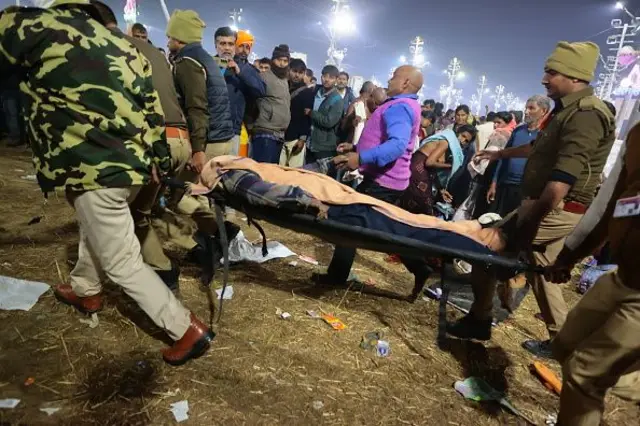A stampede occurred at the Maha Kumbh Mela in Prayagraj (Allahabad), India, resulting in numerous fatalities and dozens of people going missing. Indian authorities have not yet confirmed the exact death toll, though Prime Minister Narendra Modi expressed his condolences on the social media platform ‘X’ regarding the deaths of pilgrims at the event.
BBC Hindi reporter Vikas Pandey spoke with a health department official, who confirmed that at least 12 people were killed in the stampede. The official, speaking on condition of anonymity, mentioned seeing multiple bodies at the scene. The Maha Kumbh Mela is held once every 12 years, attracting millions of participants. It started on January 13 and lasts for about six weeks.
During the event, devotees from around the world bathe at the confluence of the sacred rivers Ganga, Yamuna, and the mythical Saraswati River, a location considered highly holy in Hindu belief. Uttar Pradesh’s Chief Minister Yogi Adityanath stated that nearly three crore people had bathed so far, and the situation was under control, advising against spreading negative news which could lead to further consequences.
How the Stampede Happened:
According to Chief Minister Yogi Adityanath, the stampede occurred around 1 or 2 AM when some devotees attempted to reach the Sangam after police removed barriers. Meanwhile, some affected individuals have criticized the event’s administration and arrangements. One attendee, Amresh Agarwal from Delhi, shared that while heading towards the Sangam ghat, he saw many people hastily making their way there. He explained that when people tried to bathe, they collided with others who were resting near the barriers, which led to them falling. As they fell, a chain reaction of pushing and shoving caused a larger crowd to collapse.
Vidhya Sahoo, an Indian national from Belgium, came to the Maha Kumbh with a group of 60 people. She reported that five of her companions were still missing. A man from Madhya Pradesh shared that his mother was injured in the stampede, and no police were present to assist them. He added that he didn’t know whether she would survive.
Government and Organizers Under Criticism:
After the stampede, sadhus and authorities urged people to avoid heading directly to the Sangam and instead bathe at nearby riverbanks. However, influential Hindu religious figure Prem Anand Puri blamed the authorities for prioritizing VIPs and neglecting the general devotees. He stated that all religious groups had demanded the Indian army take charge of the event’s management, believing that such a disaster could have been avoided if that had happened.
Opposition leader Rahul Gandhi also attributed the incident to poor management, criticizing the special attention given to VIPs while common pilgrims were ignored.
What is the Kumbh Mela?
The Kumbh Mela, which will end on February 26, has been recognized by UNESCO as an intangible cultural heritage of humanity. The festival’s origins are rooted in a mythological story about a battle between gods and demons over a pot of nectar (amrit) that grants immortality. During the battle, drops of nectar fell in four locations: Prayagraj, Haridwar, Ujjain, and Nashik. Every 12 years, the Kumbh Mela is held in these four cities, with the largest gatherings always taking place in Prayagraj.
The Maha Kumbh occurs once every 12 years, or once in 144 years, and this year’s event is particularly significant due to the alignment of celestial bodies. Some pilgrims were attracted to the sight of naked “Naga sadhus” (ascetics) dipping into cold waters, a spectacle that draws attention while also holding deep spiritual significance for devotees.
Recent Stampedes in India:
Unfortunately, stampedes are not uncommon in India, particularly during large religious gatherings. Just this month, six people were killed in a stampede at an event in Andhra Pradesh. Last year, a similar incident in Hathras, Uttar Pradesh, led to 120 deaths. According to Indian government statistics, there were 47 stampede incidents across the country in 2021 and 2022. Such tragedies often occur during religious festivals and large public events due to overcrowding and poor management.
While authorities typically make arrangements for large gatherings, issues like poor planning, inadequate crowd control, and lack of accountability in the event of accidents contribute to the increasing number of fatalities. Stampedes have also occurred in urban areas, such as the 2017 incident at a Mumbai railway station that resulted in 22 deaths, and the 1997 Delhi cinema hall fire that led to 59 deaths and 103 injuries due to a stampede.
